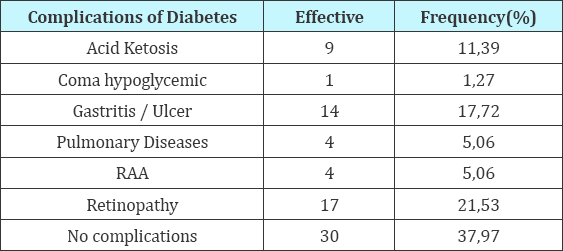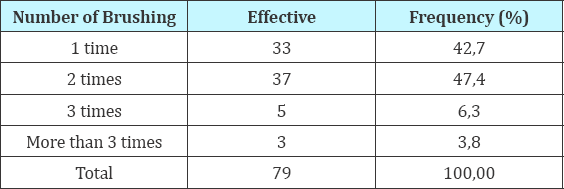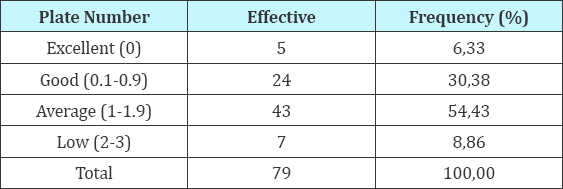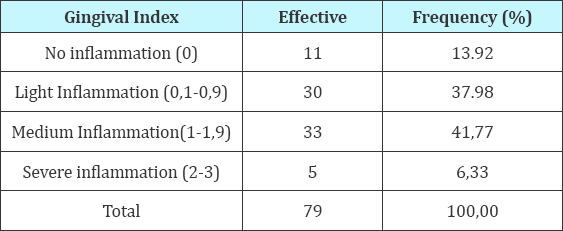- Submissions

Full Text
Modern Research in Dentistry
Oral Status of Children with Diabetes in the Hospital of Mali: 79 Observations
Niang A1*, Ba B2, Diawara O3, Ba M2, Sacko K3, Wane , Togo A4, Kane AST1, Koita H2, Toure A2, Sangare B5 and Traore AS4
1Pediatric Dentistry Service, CHU CNOS, Mali
2Oral Surgery Service, CHU CNOS, Mali
3Department of Periodontology, CHU CNOS, Mali
4Department of Internal Medicine and Endocrinology of the Hospital, Mali
5Service of Conservative Dentistry and Endodontics, CHU CNOS, Mali
*Corresponding author: Niang Amsalla, Service of Pedodontie, CHU CNOS of Bamako, BP 2067 Republic of Mali
Submission: January 31, 2018; Published: February 23, 2018

ISSN:2637-7764Volume1 Issue5
Abstract
Introduction: Diabetes is a condition characterized by chronic hyperglycemia which may be due decreased insulin levels as well as due to receptors. Unbalanced, it can lead to severe complications. Periodontal disease is one of the complications of unbalanced diabetes. This bacterial disease destroys the tissues that support teeth and causes their loss.
Objective: The objective of this study was to describe the epidemiological and clinical characteristics of the oral diseases observed in diabetic children followed at the Mali hospital.
Materials and methods: We conducted a six-month cross-sectional study based on the observation of the periodontal condition of 79 children with diabetes aged 6 to 15 years followed at the Mali Hospital. Brushing was considered normal when a child was brushing vertically. The data were collected from a survey sheet prepared for the occasion, a follow-up notebook, registers (consultation and hospitalization), entered on the Epi info 3.5.3 software, and Excel from the Microsoft Starter 2007 software. Statistical calculations were carried out with chi- 2 of Pearson with an alpha risk <0.05.
Results: We recorded 67 cases of periodontal disease, 84.81%. The male sex was represented with 51.89% of cases and a sex ratio of 1.07. The age group 12-15 years was represented with 65.6% of the cases (Table 1). Patients were students / students in 88.6% of the cases (Table 2).
All our patients had type 1 diabetes and 1 to 5 years of age in 72.15% of cases. Fifty-nine patients had blood glucose levels above 1.26g/l, i.e., 76.8% of the cases (Table 3 & 4). Forty-six of our patients had glycated hemoglobin >10% or 57.7% (Table 5), i.e., a very high risk of complications. The diseases encountered in our patients were retinopathy problems, followed by gastritis / ulcers with 34% and 28% respectively (Table 6). Children had poor brushing technique in 96.20% (Table 7) of the cases and did not know the relationship between diabetes and oral disease in 93.67% (Table 8 & 9) cases. They had a low plaque index (low oral hygiene) in 8.8% of cases (Table 10 & 11) and severe gingival inflammation in 6.33% of cases (Table 12). Children had 74.68% malocclusion, 29.11% halitosis and 56.96% dry mouth.
Conclusion: This study showed a high frequency of periodontal disease in our diabetic children population. Prevention, promotion of oral health and early detection will improve the health and quality of life of these children; Hence the need to integrate the odontologist into the multidisciplinary team of diabetic children.
Keywords: Children; Diabetes; Gingival inflammation; Plaque index; Affections; Oral
Introduction
Table 1: Workforce distribution by age range.

Table 2: Distribution by level of study.

Table 3: Breakdown of the workforce by BMI.

Table 4: Breakdown of the workforce by blood glucose level.

Table 5: Result of glycated hemoglobin.

Table 6: Distribution by complications of diabetes.

Table 7: Breakdown of the population according to the frequency of brushing.

Table 8: Distribution according to brushing techniq

Table 9: Distribution according to knowledge of the relationship between diabetes and oral diseases.

Table 10: Percentage distribution of patients by CAD teeth.

Table 11: Percentage distribution of patients by plate index.

Table 12: Percentage distribution of patients by gingival index.

Diabetes is a condition characterized by chronic hyperglycemia resulting from a deficiency of insulin secretion. Unbalanced, it can lead to severe complications. Periodontal disease is one of the complications of unbalanced diabetes. This bacterial disease destroys the tissues that support teeth and causes their loss. Prevention of dental diseases can have a beneficial effect on the balance of diabetes and the quality of life of the affected individuals [1]. Globally, an estimated 422 million people are living with diabetes in 2014, compared with 108 million in 1980. The global (age standardized) prevalence of diabetes has almost doubled since 1980, from 4.7% 8.5% [2].
Diabetes mellitus affects virtually all tissues and organs of the body, including those in the oral cavity, manifesting with several complications. These complications may include oral infections, and precancerous oral infections [3]. They are observable in children due to altered cellular immunity.
In Mali in 1996, studies in two national hospitals in Bamako showed that diabetes was the second leading cause of hospitalization and 40% of internal medicine. The prevalence of diabetes today exceeds 9.3% of the Malian population [4].
The objective of our study was to describe the epidemiological and clinical characteristics of the oral diseases observed in diabetic children followed at the hospital of Mali.
Material and Methods
We carried out a cross-sectional epidemiological study based on oral observation of children with diabetes followed at the Mali hospital in Bamako over a period of four (4) months from March 1 to June 30, 2015, on a sample of 79 patients.
In this study we administered a medical questionnaire, followed by an oral examination. Clinical characteristics of diabetes were collected from follow-up diaries, reference sheets, consultation and hospitalization records. The population concerned was the diabetic children followed in the Department of Medicine and Endocrinology of the Mali Hospital. We used the Green and Vermillon Simplified Oral Hygiene Index (IHOS) and WILKINS to assess the quality of oral hygiene. The gingival index of LOE and SILNESS for gingival inflammation and the CAD / D index for dental status. Dental mobility was assessed by the MUHLEMANN index [5]. Statistical calculations were performed with Pearson chi-2 with an alpha risk ≤0.05.
Results
We recorded 67 cases of periodontal disease, a frequency of 84.81%. The male sex accounted for 51.89% of cases for a sex ratio of 1.07. The age group 12-15 years was the most represented with 65.6% of the cases. The majority of the patients were students / students, or 88.6% of the cases.
All our patients had type 1 diabetes for 1 to 5 years in 72.15% of cases. Fifty - nine (59) patients had blood glucose levels above 1.26g/l, or 76.8% of the cases. Forty-six (46) patients had glycated hemoglobin >10% or 57.7%. The diseases observed in our patients were problems of retinopathies and gastritis / ulcers with respectively 34% and 28% of the cases.
All children brushed their teeth either 100% of the cases for a twice daily frequency of brushing (47.4%). However, a poor technique of brushing was found in 96.20% of cases and the majority of children were unaware of the relationship between diabetes and oral diseases, 93.67% of cases. A low plaque index (poor oral hygiene) was observed in 8.8% of cases for severe gingival inflammation in 6.33% of cases. Children with diabetes had a malocclusion in 74.6% of the cases, 29.1% had halitosis and 56.9% had dry mouth. The gingival index was mean in 40.5% of the cases and they had angular cheilitis, glossitis and palliative lesions respectively in 22.78%; 20.25% and 18.98%. Diabetic children did not consult with Dental Surgeon in 76.0% of cases. We found no statistical link between the socio-demographic variables and the various indices.
Discussion
In our study we recorded an overall frequency of 84.81% of cases of periodontal disease. In a study conducted in Mali, Sidibe [6] reported 80% of the cases, which is supported by other similar studies in Senegal 97.5% [7], Essama et al. [8]. In Cameroon reported 87,80% of cases of gingivitis and 12,20% of periodontitis).
The male sex was the most represented with 51.89% and a sex ratio 1.07. The most represented age group was that of 12 to 15 years, 65.6% of the cases. According to socio-professional activity, students accounted for 88.6% of the cases. In Mali, Togo [9] and Coulibaly [10] respectively reported a male predominance of 51.4% and 55.3% of cases. In Senegal, Thiam [7] reported 57.5% of male cases and Thiam [11] reported an age group of 13-15 years (62% of cases).
From the point of view of the diabetic clinical characteristics all our patients had the type 1 and a seniority of 1 to 5 years in 72.1% of the cases. Fifty-nine patients (76.8%) had blood glucose levels greater than or equal to 1.26g/l (hyperglycemic), and had glycated hemoglobin >10% in 57.7% of the cases. of diabetes. Our patients did not know the relationship between diabetes and oral disease in 93.67% of cases.
Coulibaly [10] reported in his study a blood glucose level greater than or equal to 84.6% of the cases. Thiam [7] reported a 4-year seniority in diabetes, 67% of cases. In France, Ternois et al. [12] reported in 74 diabetic children aged 1 to 17.5 years a very unbalanced glycated hemoglobin of 8 to 10% or >10%, or 54% of the cases. They reported little information about diabetes and oral health in 39% of children.
Peyraud et al. [13] reported a diabetes mellitus for less than five years, average glycated hemoglobin of 8.0±0.97% and an age of 5.92±2.75 years. The children in their study had an "acceptable" level of knowledge about oral health / diabetes links [13]. Choleau et al. [14] reported in their study an age of diabetes of 4.9±3.6 years and mean HbA1c of 8.3±1.5 in children.
In our study, children had poor oral hygiene in 8.8% and a severe gingival index in 6.33%. They had malocclusion in 74.6% (however we did not investigate the link between this condition and periodontal disease), halitosis in 29.1% and dryness in the mouth in 56.9% of cases.
Bissong et al. [3] reported in Cameroonian diabetic patients 23.5% of gingivitis; 24.8% periodontitis; 19.5% of dental caries and 21.5% of oral candidacies. Thiam [7] reported an average gingival inflammation in 72.5% of cases and average oral hygiene in 77.5% of cases. Peyraud et al. [13] reported an average CAD score of 0.80±1.38 and an average gingival index of 0.50±0.54 with better oral hygiene.
No statistical link between the periodontal status (plaque index and gingival index) and sex, age group and age of diabetes.
Conclusion
The study revealed a high frequency of oral diseases in children with diabetes. Awareness-raising campaigns and the promotion of oral health for this segment of the population are needed. It is necessary to integrate the Surgeon-Dentist into the multidisciplinary care team in order to improve the health and quality of life of the children.
References
- Rochereau T, Ley A (2008) Is the management of oral care for people with diabetes appropriate? Operation of the ESPS 2008 survey, Health Economics Issues no. 185.
- WHO (2016) World diabetes report.
- Bissong M, Azodo CC, Agbor MA, Nkuo-Akenji T, Fon PN (2015) Oral health status of diabetes mellitus patients in southwest Cameroon. Odontostomatol Trop 38(150): 49-57.
- Beran D. The management of diabetes in Mali.
- Sow A (2005) Gingival bleeding: assessment in a Dakar population (about a survey of 124 patients). Thesis Chir Dent, Dakar, Senegal, p. 14.
- Sidibe B (2014) Evaluation of the periodontal treatment needs of diabetic patients of the national center of fight against diabetes of Bamako. Thesis Chir Dent, Bamako, Mali.
- Thiam M (2005) Contribution to the study of the oral health of diabetic children. Thesis Chir Dent, Dakar, Senegal, p. 24.
- Essama EB, Bell NW, Kouotou MJS, Choukem SP (2013) Evaluation of the oral health of Cameroonian diabetic patients Health Sci Dis 14(3): 1-5.
- Togo AD (2010) Clinical and therapeutic epidemiological aspects of diabetes in children and adolescents. Thesis de Med, Bamako, Mali, p. 5.
- Coulibaly F (2014) The problem of insulin therapy in type 1 diabetics of 5 to 25 years in the department of medicine and endocrinology at the hospital of Mali Thèse Med Bamako, Mali.
- Thiam F (2006) Diabetes and Periodontal Diseases. Case-control study in children aged -15 years. Thesis chir tooth, Dakar, Senegal, p. 9.
- Ternois M (2010) Diabetes type 1: Adults and adolescents -the same oral condition? 33rd Diabetology meeting, Le Touquet, France.
- Peyrau C (2012) Oral health in children with type 1 diabetes: study in a group of 40 children. Diabetes Metab 38: A130- A132.
- Choleau C (2016) Study of insulin injection technique and feelings of young people with type 1 diabetes: impact on educational follow-up. Elsevier Masson SAA 2016 Diabetes Metab 2012(3): A130-A132.
© 2018 Niang A, et al. This is an open access article distributed under the terms of the Creative Commons Attribution License , which permits unrestricted use, distribution, and build upon your work non-commercially.
 a Creative Commons Attribution 4.0 International License. Based on a work at www.crimsonpublishers.com.
Best viewed in
a Creative Commons Attribution 4.0 International License. Based on a work at www.crimsonpublishers.com.
Best viewed in 







.jpg)






























 Editorial Board Registrations
Editorial Board Registrations Submit your Article
Submit your Article Refer a Friend
Refer a Friend Advertise With Us
Advertise With Us
.jpg)






.jpg)














.bmp)
.jpg)
.png)
.jpg)










.jpg)






.png)

.png)



.png)






